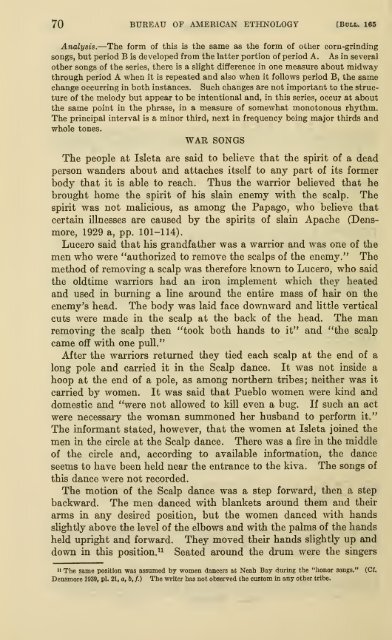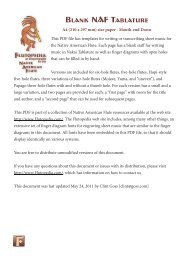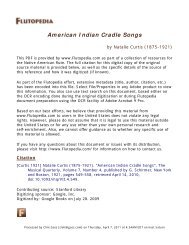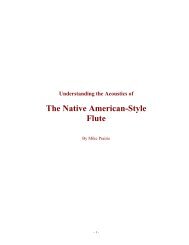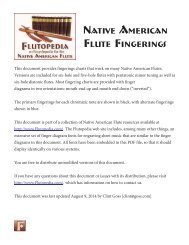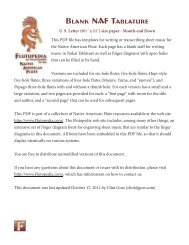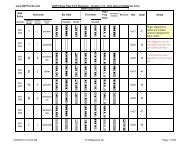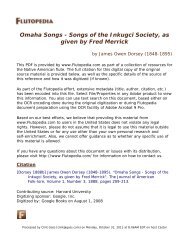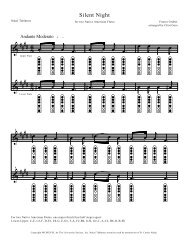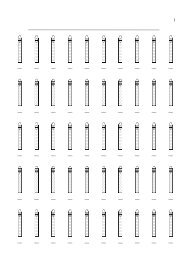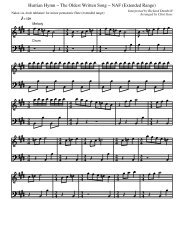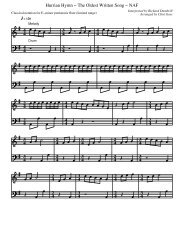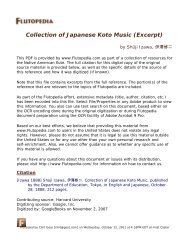Music of Acoma, Isleta, Cochiti, and Zuñi Pueblos - Flutopedia.com
Music of Acoma, Isleta, Cochiti, and Zuñi Pueblos - Flutopedia.com
Music of Acoma, Isleta, Cochiti, and Zuñi Pueblos - Flutopedia.com
Create successful ePaper yourself
Turn your PDF publications into a flip-book with our unique Google optimized e-Paper software.
70 BUREAU OF AMERICAN ETHNOLOGY [Bull. 165<br />
Analysis.—The form <strong>of</strong> this is the same as the form <strong>of</strong> other corn-grinding<br />
songs, but period B is developed from the latter portion <strong>of</strong> period A. As in several<br />
other songs <strong>of</strong> the series, there is a slight difference in one measure about midway<br />
through period A when it is repeated <strong>and</strong> also when it follows period B, the same<br />
change occurring in both instances.<br />
Such changes are not important to the structure<br />
<strong>of</strong> the melody but appear to be intentional <strong>and</strong>, in this series, occur at about<br />
the same point in the phrase, in a measure <strong>of</strong> somewhat monotonous rhythm.<br />
The principal interval is a minor third, next in frequency being major thirds <strong>and</strong><br />
whole tones.<br />
WAR SONGS<br />
The people at <strong>Isleta</strong> are said to believe that the spirit <strong>of</strong> a dead<br />
person w<strong>and</strong>ers about <strong>and</strong> attaches itself to any part <strong>of</strong> its former<br />
body that it is able to reach. Thus the warrior believed that he<br />
brought home the spirit <strong>of</strong> his slain enemy with the scalp. The<br />
spirit was not malicious, as among the Papago, who believe that<br />
certain illnesses are caused by the spirits <strong>of</strong> slain Apache (Densmore,<br />
1929 a, pp. 101-114).<br />
Lucero said that his gr<strong>and</strong>father was a warrior <strong>and</strong> was one <strong>of</strong> the<br />
men who were "authorized to remove the scalps <strong>of</strong> the enemy." The<br />
method <strong>of</strong> removing a scalp was therefore known to Lucero, who said<br />
the oldtime warriors had an iron implement which they heated<br />
<strong>and</strong> used in burning a line around the entire mass <strong>of</strong> hair on the<br />
enemy's head. The body was laid face downward <strong>and</strong> little vertical<br />
cuts were made in the scalp at the back <strong>of</strong> the head. The man<br />
removing the scalp then "took both h<strong>and</strong>s to it" <strong>and</strong> "the scalp<br />
came <strong>of</strong>f with one pull."<br />
After the warriors returned they tied each scalp at the end <strong>of</strong> a<br />
long pole <strong>and</strong> carried it in the Scalp dance. It was not inside a<br />
hoop at the end <strong>of</strong> a pole, as among northern tribes; neither was it<br />
carried by women. It was said that Pueblo women were kind <strong>and</strong><br />
domestic <strong>and</strong> "were not allowed to kill even a bug. If such an act<br />
were necessary the woman summoned her husb<strong>and</strong> to perform it."<br />
The informant stated, however, that the women at <strong>Isleta</strong> joined the<br />
men in the circle at the Scalp dance. There was a fire in the middle<br />
<strong>of</strong> the circle <strong>and</strong>, according to available information, the dance<br />
seems to have been held near the entrance to the kiva. The songs <strong>of</strong><br />
this dance were not recorded.<br />
The motion <strong>of</strong> the Scalp dance was a step forward, then a step<br />
backward. The men danced with blankets around them <strong>and</strong> their<br />
arms in any desired position, but the women danced with h<strong>and</strong>s<br />
shghtly above the level <strong>of</strong> the elbows <strong>and</strong> with the palms <strong>of</strong> the h<strong>and</strong>s<br />
held upright <strong>and</strong> forward. They moved their h<strong>and</strong>s slightly up <strong>and</strong><br />
down in this position." Seated around the drum were the singers<br />
•1 The same position was assumed by women dancers at Neah Bay during the "honor songs." (Cf.<br />
Densmore 1939, pi. 21, a, 6, /.)<br />
The writer has not observed the custom in any other tribe.


